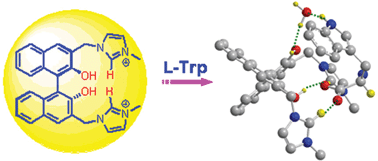A type of 1,1′-binaphthyl-based imidazolium chemosensor module has been synthesized for the highly selective recognition of tryptophan (Trp) among the eleven α-amino acids investigated in aqueous solutions via synergistic effects of multiple hydrogen bonding and electrostatic interactions. These results have demonstrated that the C-2 hydrogen atom of the imidazolium ring plays a key role as a hydrogen bond donor. The UV/vis, fluorescence and mass spectral studies have indicated that a 1 : 1 complex is formed between the host and tryptophan. The binding affinity and selectivity of the cleft-like receptor (R)-1 with L-Trp are superior to those of (R)-2–5. In spite of an inferior selectivity towards various aromatic amino acids, the macrocyclic (R)-3 displays a remarkable enantiodiscrimination for the two enantiomers of tryptophan with a KD/KL value as high as 6.2.

